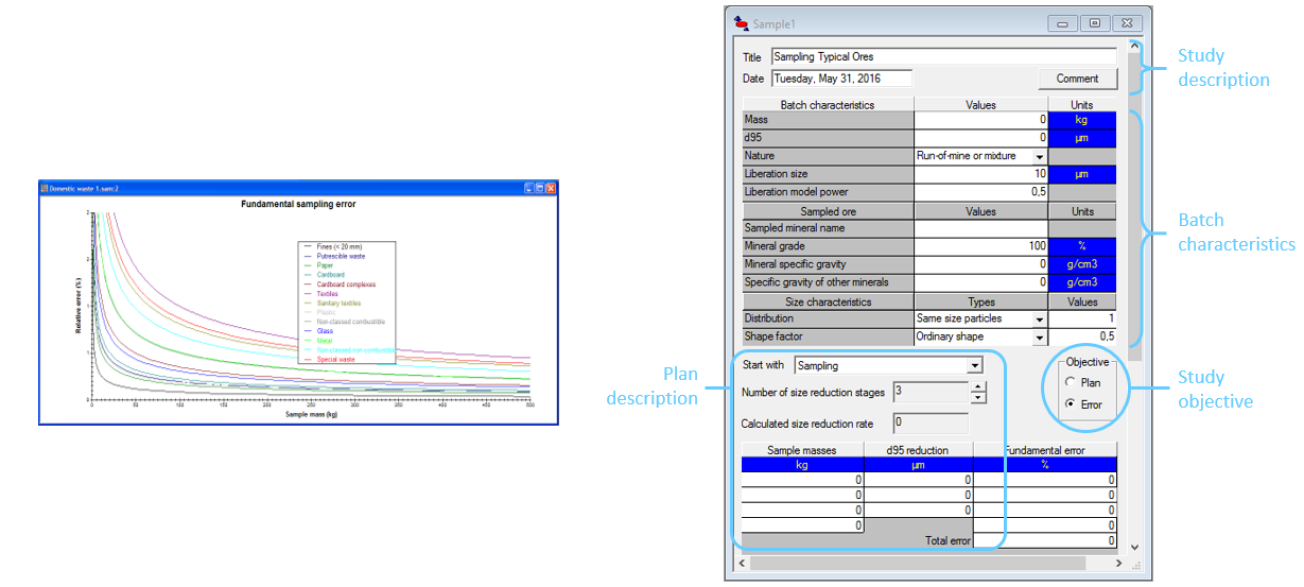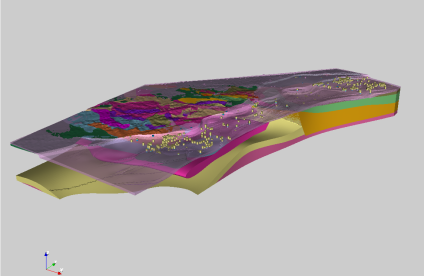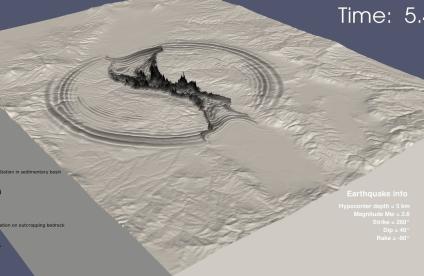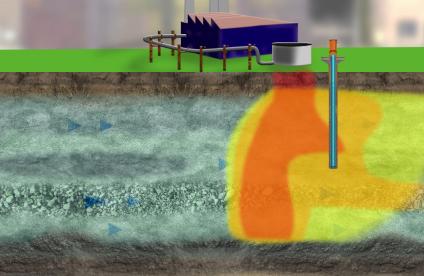
Les déchets électroniques et électriques : un gisement de métaux et de terres rares (Orléans, 2016).
© BRGM
L'échantillonnage est l'opération cherchant à représenter un lot de matière par une fraction souvent très réduite de celui-ci. C’est un préalable à toute prise de décision en génie des procédés : élaboration d’un procédé, diagnostic d’un site, audit d’une installation, négociation du prix de la matière…
Le prélèvement d’un échantillon de matière est un processus aléatoire qui engendre des erreurs d’échantillonnage. Les erreurs d’échantillonnage sont un sujet d’attention lorsque l’on manipule des matières ou des mélanges solides, notamment lorsqu’il y a un enjeu commercial sur la matière étudiée. Les principales erreurs résultent de l’hétérogénéité de la matière à échantillonner et de la difficulté à recueillir un échantillon représentatif.
Fondé sur la théorie de Pierre Gy (ToS, Theory of Sampling), le logiciel ECHANT calcule l'erreur fondamentale d'échantillonnage (EFE). Il est une aide précieuse dans la mise en place d’une stratégie d'échantillonnage de matières hétérogènes. Il est utile pour :
- définir des campagne d’échantillonnage fiables,
- mieux maîtriser les performances d’un procédé,
- améliorer la qualité des produits.
Principales caractéristiques du logiciel d’échantillonnage ECHANT
Les principales caractéristiques d’ECHANT sont les suivantes :
- scénarios d’échantillonnage intégrés pour diverses applications,
- calcul de l’erreur fondamentale d’échantillonnage (EFE),
- conception par étape des plans,
- caractérisation précise de la matière à échantillonner,
- représentation graphique de la variation de l’EFE avec la masse d’échantillon.
BILCO, USIM PAC et ECHANT : une suite complète pour analyser les procédés de transformation
Avec le logiciel de bilan matière BILCO et le simulateur de procédés USIM PAC, ECHANT forme une suite complète pour analyser les procédés de transformation.
Les logiciels BILCO, USIM PAC et ECHANT, dont le BRGM est l’auteur, sont édités depuis 2004 par la société Caspeo, qui continue d’en étendre les fonctionnalités.
Fonctionnalités
ECHANT est un logiciel de calcul d’échantillonnage tout-en-un. Il permet, pour une matière donnée :
- le calcul de la masse minimale d’un échantillon : élaboration d’un plan d’échantillonnage en fixant des limites pour l’EFE,
- le calcul de l’erreur d’échantillonnage maximale : estimation de l’erreur d’échantillonnage maximale pour une masse donnée d’échantillon.
Cet outil d’aide à la décision permet d’étudier différents paramètres : teneur, concentration, humidité, distribution granulométrique... Si les valeurs sont inconnues, ECHANT les estime à partir d’autres paramètres connus et adapte les calculs.

Interface du logiciel ECHANT : EFE fonction de la masse d’échantillon - échantillonnage de déchets grâce au logiciel ECHANT (à gauche), échantillonnage de minerais (à droite).
© Caspeo
Applications
Conçu à l’origine pour le traitement de minerais, le logiciel ECHANT est aujourd’hui utilisé dans de nombreuses industries mettant en œuvre des matières solides ou des mélanges (particules, agrégats, multi-phases) :
- Mines : humidité, distribution granulométrique, teneur en éléments/minéraux
- Déchets : composition, teneur en polluants
- Sols pollués
- Agroalimentaire, biomasse
- Pharmacie
- Cosmétique
- etc.
Pour aller plus loin
Publications
Brochot, S., Garcin-Schroeder, V. and Wavrer, P. (2019) - The Choice of the Heterogeneity Model to Better Estimate the Intrinsic Heterogeneity. Proceedings of WSCB 2019, the 9th World Conference on Sampling and Blending, Beijing, China, May 2019, pp. 308-315
Brochot, S., Wavrer, P. and Opanasenko, S. - How Sampling Error Calculation Can Enhance the Measurement System in a Chromite Concentrator. Proceedings of WSCB 2019, the 9th World Conference on Sampling and Blending, Beijing, China, May 2019, pp. 417-426
Wavrer, P. (2018) - Theory of Sampling (TOS) applied to characterisation of Municipal Solid Waste (MSW) - a case study from France. TOS forum, Issue 8, p. 3 (full article). https://www.impopen.com/tosf-abstract/S08_0103
Maris, E., Botane, P., Wavrer, P., Froelich, D. (2015) - Characterizing plastics originating from WEEE: A case study in France. Minerals Engineering Volume 76, 15 May 2015, Pages 28-37. https://www.sciencedirect.com/science/article/abs/pii/S0892687514004415
Brochot, S., Mounié, F. (2015) - Placer gold sampling - The overall measurement error using gravity concentration on particle size ranges during sample treatment. Proceedings of WSCB 2015, the 7th World Conference on Sampling and Blending, France - TOS forum June 2015, (5):43 (full article). https://www.impopen.com/tosf-abstract/S05_0043
Brochot, S. (2013) - Application of sampling theory to optimal design of size distribution measurement procedures. Proceedings of WSCB 2013, the 6th World Conference on Sampling and Blending, Peru.
Wavrer, P., Botane, P., Brochot, S. (2013) - Sampling protocol design for characterization of plastics from small WEEE. WSCB 2013, the 6th World Conference on Sampling and Blending, Peru.
Brochot, S. (2013) - Application of sampling theory to optimal design of size distribution measurement procedures. Proceedings of the Sixth World Conference on Sampling and Blending, Ed by J. Beniscelli, J. Felipe Costa, O. Domínguez, S. Duggan, K. Esbensen, G. Lyman, B. Sanfurgo. Gecamin, Santiago de Chile, pp. 129–140 (2013).
Wavrer, P., Botane, P., Brochot, S. - Sampling protocol design for characterization of plastics from small WEEE. Proceedings of the Sixth World Conference on Sampling and Blending, Ed by J. Beniscelli, J. Felipe Costa, O. Domínguez, S. Duggan, K. Esbensen, G. Lyman, B. Sanfurgo. Gecamin, Santiago de Chile, pp. 143–152 (2013).
Brochot, S. (2012) - Standard Fire Assay or Screen Fire Assay? Application of the overall measurement error approach to choose the most appropriate method. Proceedings of the Sampling 2012 Conference AusIMM, Perth, Western Australia, Australia, pp. 135–142.
Brochot, S. (2012) - Sampling for grinding pilot plant test: the effect of size distribution variability. Proceedings of the Sampling 2012 Conference AusIMM, Perth, Western Australia, Australia, 27–28 August, pp. 127–134.
Brochot, S. (2003)- ECHANT: A Sampling Aid Tool, paper presented at First World Conference on Sampling and Blending, Esbjerg.







